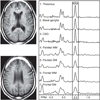Exploring the relationship of macrophage colony-stimulating factor levels on neuroaxonal metabolism and cognition during chronic human immunodeficiency virus infection
- PMID: 20839921
- PMCID: PMC3164773
- DOI: 10.3109/13550284.2010.513029
Exploring the relationship of macrophage colony-stimulating factor levels on neuroaxonal metabolism and cognition during chronic human immunodeficiency virus infection
Abstract
Macrophage colony-stimulating factor (M-CSF) promotes macrophage differentiation, increases susceptibility of macrophages to viral infection, and enhances human immunodeficiency virus (HIV) replication in infected macrophages. Given the current model of HIV neuropathogenesis, which involves monocyte trafficking into the central nervous system, immune factors linked with macrophage maturation and survival may be associated with cognitive decline (measured by neuropsychological z-score [NPZ-8] or Memorial Sloan-Kettering [MSK] score) and alterations in a marker of neuronal integrity, N-acetylaspartate (NAA). Fifty-four chronically infected HIV+ subjects underwent neuropsychological assessment, magnetic resonance spectroscopic imaging, and quantification of M-CSF in plasma and cerebrospinal fluid (CSF) at baseline. Thirty-nine of those subjects underwent further examination at 3 and 10 months after initiation of combination antiretroviral therapy (ART) regimens. Within 3 months of therapy use, CSF M-CSF and viral RNA levels were reduced, whereas NAA concentrations in many brain regions were increased. Neither baseline levels nor the change in M-CSF levels had the ability to predict changes in NAA levels observed after 10 months of combination ART use. At study entry those with the lowest M-CSF levels in the CSF had the least cognitive impairment (NPZ-8). Those who had higher baseline CSF M-CSF levels and exhibited larger decreases in M-CSF after therapy, tended to have greater cognitive improvement after 10 months. Increased prevalence of M-CSF in the setting of HIV infection could contribute to neuronal injury and may be predictive of cognitive impairment.
Conflict of interest statement
Figures


Similar articles
-
Evaluation of HIV RNA and markers of immune activation as predictors of HIV-associated dementia.Neurology. 2004 Dec 14;63(11):2084-90. doi: 10.1212/01.wnl.0000145763.68284.15. Neurology. 2004. PMID: 15596754
-
Progressive cerebral injury in the setting of chronic HIV infection and antiretroviral therapy.J Neurovirol. 2013 Jun;19(3):209-18. doi: 10.1007/s13365-013-0162-1. Epub 2013 Apr 24. J Neurovirol. 2013. PMID: 23613008 Free PMC article.
-
Antiretroviral treatment alters relationship between MCP-1 and neurometabolites in HIV patients.Antivir Ther. 2004 Jun;9(3):431-40. doi: 10.1177/135965350400900302. Antivir Ther. 2004. PMID: 15259906 Clinical Trial.
-
Macrophage colony-stimulating factor in the pathogenesis of HIV infection: potential target for therapeutic intervention.J Neuroimmune Pharmacol. 2006 Mar;1(1):32-40. doi: 10.1007/s11481-005-9003-1. J Neuroimmune Pharmacol. 2006. PMID: 18040789 Review.
-
Antiretroviral drug treatment interruption in human immunodeficiency virus-infected adults: Clinical and pathogenetic implications for the central nervous system.J Neurovirol. 2004;10 Suppl 1:44-51. doi: 10.1080/753312752. J Neurovirol. 2004. PMID: 14982739 Review.
Cited by
-
Evidence for cFMS signaling in HIV production by brain macrophages and microglia.J Neurovirol. 2015 Jun;21(3):249-56. doi: 10.1007/s13365-014-0270-6. Epub 2014 Jul 25. J Neurovirol. 2015. PMID: 25060299 Free PMC article.
-
A peripheral monocyte interferon phenotype in HIV infection correlates with a decrease in magnetic resonance spectroscopy metabolite concentrations.AIDS. 2011 Sep 10;25(14):1721-6. doi: 10.1097/QAD.0b013e328349f022. AIDS. 2011. PMID: 21750421 Free PMC article.
-
Microglia proliferation underlies synaptic dysfunction in the prefrontal cortex: implications for the pathogenesis of HIV-1-associated neurocognitive and affective alterations.J Neurovirol. 2023 Aug;29(4):460-471. doi: 10.1007/s13365-023-01147-x. Epub 2023 May 24. J Neurovirol. 2023. PMID: 37222970 Free PMC article.
-
7T Brain MRS in HIV Infection: Correlation with Cognitive Impairment and Performance on Neuropsychological Tests.AJNR Am J Neuroradiol. 2018 Apr;39(4):704-712. doi: 10.3174/ajnr.A5547. Epub 2018 Feb 15. AJNR Am J Neuroradiol. 2018. PMID: 29449278 Free PMC article.
-
M-CSF increases proliferation and phagocytosis while modulating receptor and transcription factor expression in adult human microglia.J Neuroinflammation. 2013 Jul 17;10:85. doi: 10.1186/1742-2094-10-85. J Neuroinflammation. 2013. PMID: 23866312 Free PMC article.
References
-
- Aquaro S, Svicher V, Schols D, Pollicita M, Antinori A, Balzarini J, Perno CF. Mechanisms underlying activity of antiretroviral drugs in HIV-1-infected macrophages: new therapeutic strategies. J Leukoc Biol. 2006;80:1103–1110. - PubMed
-
- Barker PB. N-acetyl aspartate—a neuronal marker? Ann Neurol. 2001;49:423–424. - PubMed
-
- Bosch B, Clotet-Codina I, Blanco J, Pauls E, Coma G, Cedeno S, Mitjans F, Llano A, Bofill M, Clotet B, Piulats J, Este JA. Inhibition of human immunodeficiency virus type 1 infection in macrophages by an alpha-v integrin blocking antibody. Antiviral Res. 2006;69:173–180. - PubMed
-
- Canque B, Rosenqwajg M, Gey A, Tartour E, Fridman WH, Gluckman JC. Macrophage inflammatory protein-1alpha is induced by human immunodeficiency virus infection of monocyte-derived macrophages. Blood. 1996;87:2011–2019. - PubMed
Publication types
MeSH terms
Substances
Grants and funding
LinkOut - more resources
Full Text Sources
Research Materials

